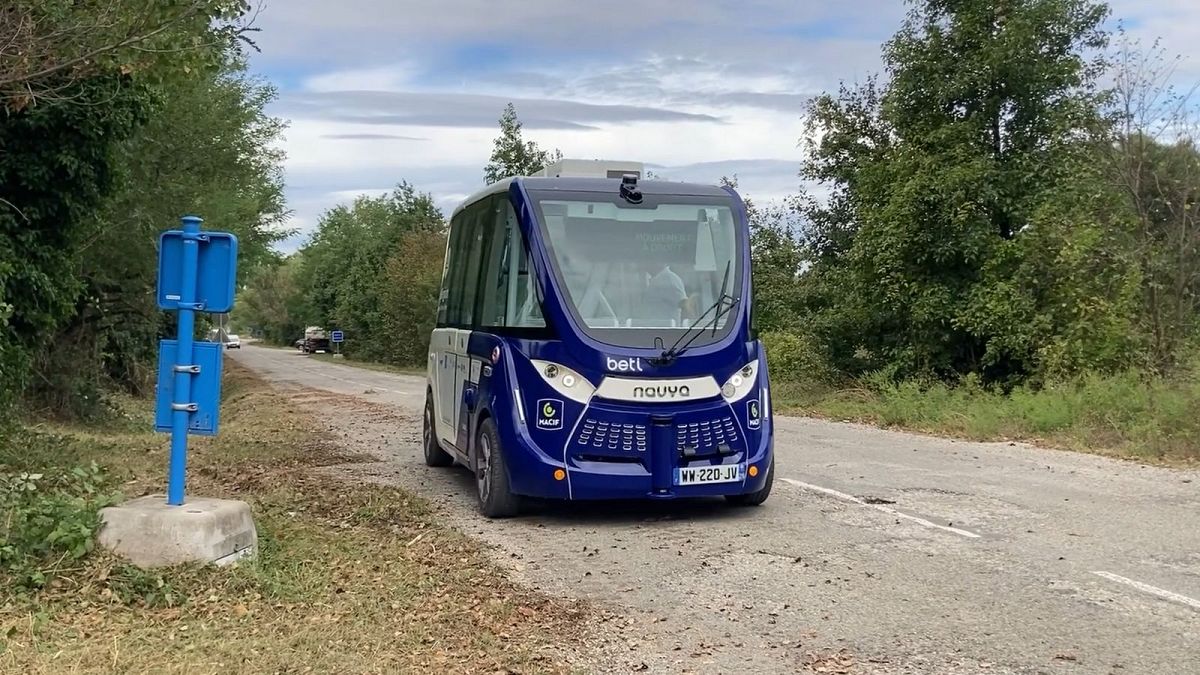Driverless Shuttles: A New Era of Mobility in Rural France
Driverless Shuttles: A New Era of Mobility in Rural France
In the picturesque yet sparsely populated region of Val de Drôme – Crest in southeastern France, a quiet revolution is underway. The deployment of self-driving shuttles is transforming the way residents navigate their rural surroundings. This initiative, launched in 2020, is part of a broader European effort to harness automated electric vehicles (EVs) as a viable public transport solution in areas where traditional services are often lacking.Yann Arnaud, director of responses to customer needs and innovation at the French insurance company MACIF, emphasized the potential of these shuttles during a conversation with Euronews. “We are trying to ensure that this is a new means of travel and mobility for people living in suburban or rural areas,” he stated, highlighting the project’s aim to reduce isolation and improve accessibility.

Technology and Safety
The shuttles operate on a predefined 5 km route, making seven stops over a 20-minute journey. A control operator oversees the operation to ensure safety. Benjamin Beaudet, general director at Beti, the operator of the automated shuttles, explained that the technology aligns with the European vision for automated vehicles. The shuttles “learn” their routes and compare real-time observations with pre-learned data to navigate safely.In contrast to American and Chinese companies like Waymo, Uber, and Tesla, which focus on self-driving taxis with flexible routes, the European approach prioritizes defined paths, enhancing safety and predictability.
Addressing Rural Needs
The introduction of these shuttles in Val de Drôme – Crest, where the population density is significantly lower than the national average, has been met with positive feedback. Residents appreciate the newfound mobility options, especially in areas where alternatives are limited. Arnaud noted, “The question of acceptability arises when you have the luxury of having other options. When you don’t have a choice, you’re very happy to have [the shuttle].”This sentiment underscores the potential of driverless vehicles to address mobility challenges in rural areas, particularly for the elderly and those without access to personal transportation.
Challenges and Future Prospects
Despite the promising start, scaling these projects to permanent services remains a challenge. High costs, logistical hurdles, and technological requirements, as outlined in an Open Research Europe article, pose significant barriers. The EU has invested €159 million in research and innovation related to automated mobility since 2021, yet achieving commercial viability continues to be elusive.The success of initiatives like AVENUE and SHOW, which have conducted pilot projects across Europe, including in Crest, offers hope. However, transitioning from pilot programs to sustainable, everyday solutions requires overcoming substantial obstacles.
As Europe continues to explore the potential of automated vehicles, the experiences in rural France provide valuable insights into the future of mobility. With continued innovation and investment, driverless shuttles could become a cornerstone of public transport in remote areas, offering a greener, more accessible alternative to traditional car use.
More Articles
Getting licensed or staying ahead in your career can be a journey—but it doesn’t have to be overwhelming. Grab your favorite coffee or tea, take a moment to relax, and browse through our articles. Whether you’re just starting out or renewing your expertise, we’ve got tips, insights, and advice to keep you moving forward. Here’s to your success—one sip and one step at a time!
2407, 2023
Oklahoma
Forgive the Cyber Dust
We will return shortly after upgrades are complete
2407, 2023
Ohio
Forgive the Cyber Dust
We will return shortly after upgrades are complete
2407, 2023
North Dakota
Forgive the Cyber Dust
We will return shortly after upgrades are complete
2407, 2023
North Carolina
Forgive the Cyber Dust
We will return shortly after upgrades are complete
2407, 2023
New York
Forgive the Cyber Dust
We will return shortly after upgrades are complete
2407, 2023
New Mexico
Forgive the Cyber Dust
We will return shortly after upgrades are complete
2407, 2023
New Jersey
Forgive the Cyber Dust
We will return shortly after upgrades are complete
2407, 2023
New Hampshire
Forgive the Cyber Dust
We will return shortly after upgrades are complete
2407, 2023
Nevada
Forgive the Cyber Dust
We will return shortly after upgrades are complete
2407, 2023
Nebraska
Forgive the Cyber Dust
We will return shortly after upgrades are complete
2407, 2023
Montana
Forgive the Cyber Dust
We will return shortly after upgrades are complete
2407, 2023
Missouri
Forgive the Cyber Dust
We will return shortly after upgrades are complete
2407, 2023
Mississippi
Forgive the Cyber Dust
We will return shortly after upgrades are complete
2407, 2023
Minnesota
Forgive the Cyber Dust
We will return shortly after upgrades are complete
2407, 2023
Michigan
Forgive the Cyber Dust
We will return shortly after upgrades are complete
2407, 2023
Massachusetts
Forgive the Cyber Dust
We will return shortly after upgrades are complete
2407, 2023
Maryland
Forgive the Cyber Dust
We will return shortly after upgrades are complete
2407, 2023
Maine
Forgive the Cyber Dust
We will return shortly after upgrades are complete
2407, 2023
Louisiana
Forgive the Cyber Dust
We will return shortly after upgrades are complete
2407, 2023
Kentucky
Forgive the Cyber Dust
We will return shortly after upgrades are complete
2407, 2023
Kansas
Forgive the Cyber Dust
We will return shortly after upgrades are complete
2407, 2023
Iowa
Forgive the Cyber Dust
We will return shortly after upgrades are complete
2407, 2023
Indiana
Forgive the Cyber Dust
We will return shortly after upgrades are complete
2407, 2023
Illinois
Forgive the Cyber Dust
We will return shortly after upgrades are complete
2407, 2023








